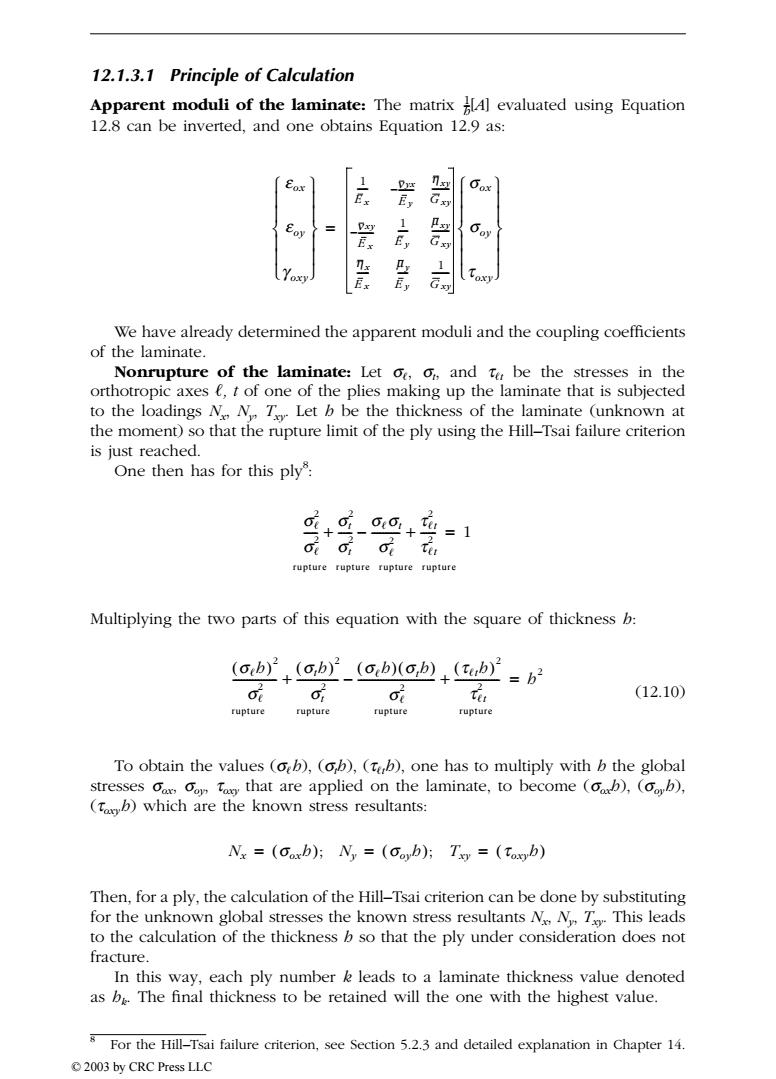正在加载图片...

12.1.3.1 Principle of Calculation Apparent moduli of the laminate:The matrix A]evaluated using Equation 12.8 can be inverted,and one obtains Equation 12.9 as: Eox _P四 n E Ey Ey We have already determined the apparent moduli and the coupling coefficients of the laminate. Nonrupture of the laminate:Let o,o,and te be the stresses in the orthotropic axes t,t of one of the plies making up the laminate that is subjected to the loadings NN.T Let b be the thickness of the laminate (unknown at the moment)so that the rupture limit of the ply using the Hill-Tsai failure criterion is just reached. One then has for this ply: _+ -1 rupture rupture rupture rupture Multiplying the two parts of this equation with the square of thickness b: (Gb)b)(b)(b)(b)=b o o Tit (12.10) rupture rupture rupture rupture To obtain the values (ob),(ob),(tb),one has to multiply with b the global stresses t that are applied on the laminate,to become (ab),(b), (Tab)which are the known stress resultants: N =(Goxb);Ny =(Gob);T=(Tob) Then,for a ply,the calculation of the Hill-Tsai criterion can be done by substituting for the unknown global stresses the known stress resultants NN.T This leads to the calculation of the thickness b so that the ply under consideration does not fracture. In this way,each ply number k leads to a laminate thickness value denoted as b.The final thickness to be retained will the one with the highest value. For the Hill-Tsai failure criterion,see Section 5.2.3 and detailed explanation in Chapter 14. 2003 by CRC Press LLC12.1.3.1 Principle of Calculation Apparent moduli of the laminate: The matrix [A] evaluated using Equation 12.8 can be inverted, and one obtains Equation 12.9 as: We have already determined the apparent moduli and the coupling coefficients of the laminate. Nonrupture of the laminate: Let s, st , and tt be the stresses in the orthotropic axes , t of one of the plies making up the laminate that is subjected to the loadings Nx, Ny, Txy. Let h be the thickness of the laminate (unknown at the moment) so that the rupture limit of the ply using the Hill–Tsai failure criterion is just reached. One then has for this ply8 : Multiplying the two parts of this equation with the square of thickness h: (12.10) To obtain the values (sh), (st h), (tth), one has to multiply with h the global stresses sox, soy, toxy that are applied on the laminate, to become (soxh), (soyh), (toxyh) which are the known stress resultants: Then, for a ply, the calculation of the Hill–Tsai criterion can be done by substituting for the unknown global stresses the known stress resultants Nx, Ny, Txy. This leads to the calculation of the thickness h so that the ply under consideration does not fracture. In this way, each ply number k leads to a laminate thickness value denoted as hk. The final thickness to be retained will the one with the highest value. 8 For the Hill–Tsai failure criterion, see Section 5.2.3 and detailed explanation in Chapter 14. 1 h -- e ox e oy Óg oxy ˛ Ô Ô Ô Ô Ì ˝ Ô Ô Ô Ô Ï ¸ 1 E x ----- nyx E y –------- h xy G xy -------- n xy E x –------- 1 E y ----- m xy G xy -------- h x E x ----- m y E y ----- 1 G xy -------- sox soy Ót oxy ˛ Ô Ô Ô Ô Ì ˝ Ô Ô Ô Ô Ï ¸ = s 2 s 2 ----- st 2 st 2 ----- sst s 2 – ---------- t t 2 t t 2 + + ----- = 1 rupture rupture rupture rupture ( ) sh 2 s 2 --------------- ( ) sth 2 st 2 --------------- ( ) sh ( ) sth s 2 – --------------------------- ( ) t th 2 t t 2 + + ---------------- h2 = rupture rupture rupture rupture Nx == = ( ) soxh ; Ny ( ) soyh ; Txy ( ) t oxyh TX846_Frame_C12 Page 240 Monday, November 18, 2002 12:27 PM © 2003 by CRC Press LLC